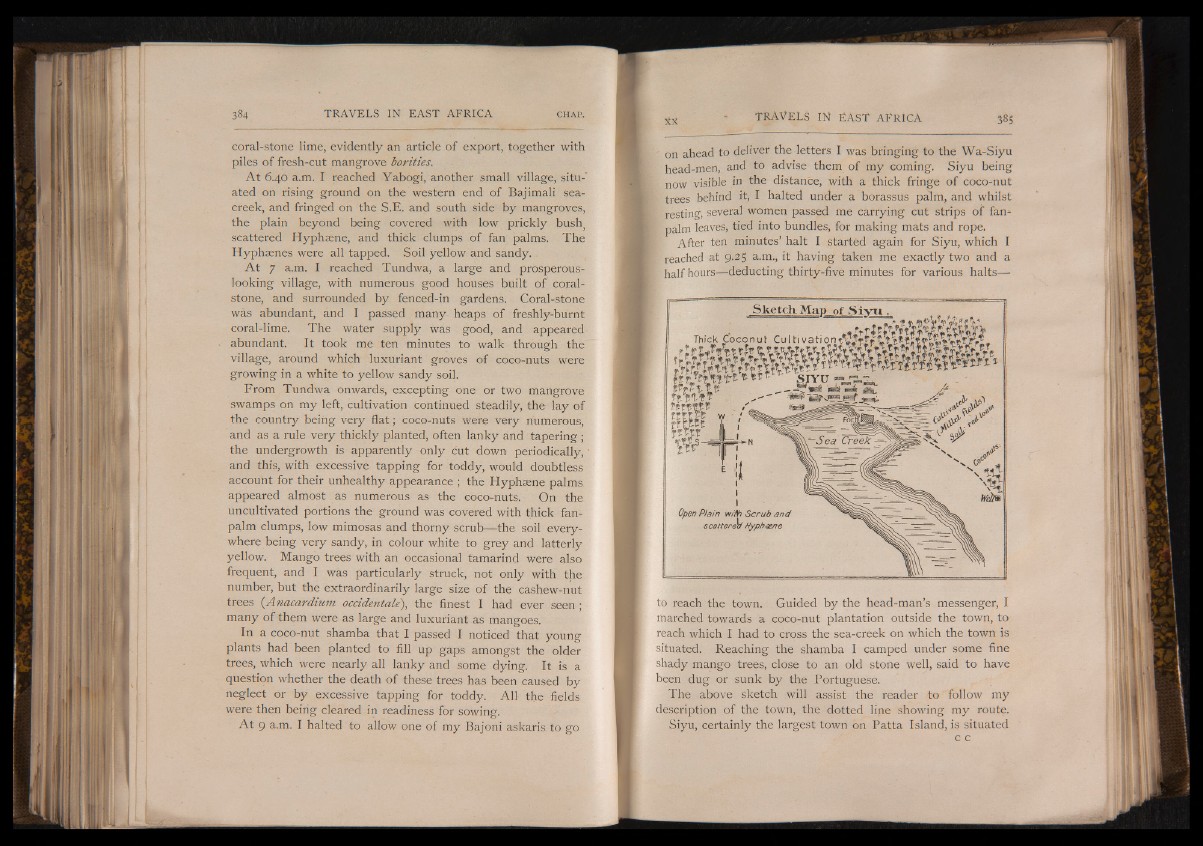
coral-stone lime, evidently an article of export, together with
piles of fresh-cut mangrove borities.
A t 6.40 a.m. I reached Yabógi, another small village, situated
on rising ground on the western end of Bajimali sea-
creek, and fringed on the S.E. and south side by mangroves,
the plain beyond being covered with low prickly bushj
scattered Hyphsene, and thick clumps of fan palms. The
Hyphaenes were all tapped. Soil yellow and sandy. .
A t 7 a.m. I reached Tundwa, a large and prosperous-
looking village, with numerous good houses built of coral-
stone, and surrounded by fenced-in gardens. Coral-stone
was abundant, and I passed many heaps of freshly-burnt
coral-lime. The water supply was good, and appeared
abundant. It took me ten minutes to walk through the
village, around which luxuriant groves of coco-nuts were
growing in a white to yellow sandy soil.
From Tundwa onwards, excepting one or two mangrove
swamps on my left, cultivation continued steadily, the lay of
the country being very flat; coco-nuts were very numerous,
and as a rule very thickly planted, often lanky and tapering;
the undergrowth is apparently only cut down periodically,
and this, with excessive tapping for toddy, would doubtless
account for their unhealthy appearance ; the Hyphaene palms
appeared almost as numerous as the coco-nuts. On the
uncultivated portions the ground was covered with thick fan-
palm clumps, low mimosas and thorny scrub— the soil everywhere
being very sandy, in colour white to grey and latterly
yellow. Mango trees with an occasional tamarind were also
frequent, and I was particularly struck, not only with the
number, but the extraordinarily large size of the cashew-nut
trees (.Anacardium occidentale), the finest I had ever seen;
many of them were as large and luxuriant as mangoes.
In a coco-nut shamba that I passed I noticed that young
plants had been planted to fill up gaps amongst the older
trees, which were nearly all lanky and some dying. It is a
question whether the death of these trees has been caused by
neglect or by excessive tapping for toddy. All the fields
were then being cleared in readiness for sowing.
A t 9 a.m. I halted to allow one of my Bajoni askaris to go
on ahead to deliver the letters I was bringing to the Wa-Siyu
head-men, and to advise them of my Goming. Siyu being
now visible in the distance, with a thick fringe of coco-nut
trees behind it, I halted under a borassus palm, and whilst
resting, several women passed me carrying cut strips of fan-
palm leaves, tied into bundles, for making mats and rope.
After ten minutes’ halt I started again for Siyu, which I
reached at 9.25 a.m., it having taken me exactly two and a
half hours— deducting thirty-five minutes for various halts—•
S k e tch Map of S i y u .
Thick Coconut Cultivati
r! p iJ r v w h t
f
I
tr-ni&K
t .n ip I - ;
r ttlU i
Open Plain with Scrub „
scattered Hyphaene
to reach the town. Guided by the head-man’s messenger, I
marched towards a coco-nut plantation outside the town, to
reach which I had to cross the sea-creek on which the town is
situated. Reaching the shamba I camped under some fine
shady mango trees, close to an old stone well, said to have
been dug or sunk by the Portuguese.
The above sketch will assist the reader to follow my
description of the town, the dotted line showing my route.
Siyu, certainly the largest town on Patta Island, is situated